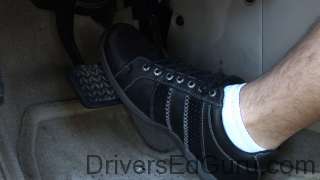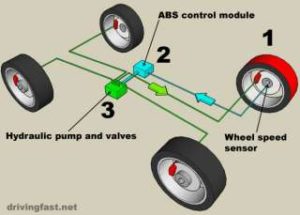Stage 2: Understanding Braking

There are only two ways to prevent collisions: don’t hit stuff and don’t let stuff hit you. Obviously, you can’t control everything around you or depend on other cars to behave rationally. So, you must focus on driving defensively, which means being prepared for other drivers to take wildly unexpected (and stupid) actions.
When you’re traveling at city or highway speeds, the driving environment can change in an instant. This is why your teen must learn how to safely brake out of potentially dangerous situations.
Like all things driving-related, this is easier said than done. So, in order to help your teen become a collision-free driver, you must practice controlled braking.
We’re ABS lovers
Because nearly every car made in the last 15-20 years has ABS brakes, we’re not going to bother discussing disc or drum brakes. There is plenty of information out there about how to use these older systems and you’re free to do that research yourself. If you do not have ABS brakes, we suggest you skip this lesson. We also suggest that you do whatever you can to get a car equipped with ABS.

How ABS brakes work
The ABS system prevents your wheels from locking up when you apply extreme pressure to your brake pedal. This is important because wheels which have become locked are essentially useless. When your wheels are locked, your tires will not rotate which means you’re skidding.
The ABS system pumps your brakes faster and smarter than you can. The system applies pressure until it senses the wheels about to lock up. It then backs off and then applies more brake pressure as your wheels start to spin too fast. This braking and “un-braking” happens as often as 20 times per second. ABS allows you to steer the vehicle while applying extreme pressure to the brakes.
ABS brakes are noisy
Anti-lock brakes do all sorts of strange things when engaged. The brake pedal will pulse and vibrate at an extremely high rate. The brake pedal may suddenly drop and you may even hear some unpleasant grinding noises. This is normal and it means that your ABS brakes are working properly. This is probably the only situation in which horrible noises coming from your car is a good thing.
Don’t ever pump ABS brakes
Since the ABS system does not engage during normal driving, its behavior can scare many drivers into backing off the brake pedal. Don’t do that! If you need to stop, keep pressure on the pedal. Pumping the brake completely negates the ABS system.
Of course, the only way to prepare yourself for what the ABS system feels like is to engage it. You don’t want your teen’s first experience with the ABS system to be during an emergency.
The Three Stages of Braking
Bringing a car to a stop requires three actions to occur:
- Your brain must recognize the need to brake. This can take a heck of a lot longer for a new driver than an experienced driver. New drivers simply don’t have the experience to recognize when the cars in front of them are slowing down. An alert driver may make this decision in 3/4 of a second. A new driver may take up to two seconds.
- You must move your foot into braking position. This may require moving your foot from the accelerator to the brake. This takes the average driver 3/4 of a second.
- Finally, you must apply pressure to the brake.
During the time in which your teen is deciding to brake and moving their foot to the pedal, their car is continuing at the same speed toward the car in front of it.
Check out the chart below which illustrates just how far the car travels during these stages of braking.
| 30 mph | 40 mph | 55 mph | 65 mph | |
| Reaction Time Distance 1 | 55 feet | 73 feet |
100 feet |
120 feet |
| Foot to Pedal Distance 2 | 33 feet | 44 feet |
60 feet |
71 feet |
| Braking Distance 3 | 43 feet |
76 feet |
144 feet |
202 feet |
| Total Stopping Distance | 131feet | 193 feet | 304 feet | 393 feet |
1. Assumes 1.25 second reaction time.
2. Assumes 0.75 second “foot to pedal” time.
3. Based upon the Vehicle Stopping Distance Calculator from CSGNetwork.com with a coefficient of friction of 0.7.
* 1 mph = 1.4666 feet per second.
Obviously, to make your teen a safer driver, you want to reduce their reaction time and reduce the time it takes them to get their foot in position to start braking. This will inevitably lead to shorter stopping distances.
Reducing Your Teen’s Stopping Distance
There isn’t much you can do to reduce the braking distance of your car because it’s a function of the size of your car, your brakes, and your tire’s tread. Obviously, if your tires or brakes require maintenance, do it. Other than that, you’ll need to focus on your teen’s reaction and foot-to-pedal times in order to reduce their overall stopping distance.
Cover braking
The simplest way to decrease the time it takes for your teen to move their foot from the accelerator to the brake is to teach them “cover braking”. Cover braking is a technique in which you rest your foot over the brake pedal in anticipation of needing to brake. Any time you feel that you may need to brake, pivot your foot from the accelerator to the brake pedal. However, you do not push the brake. You simply rest your foot on the pedal.
By using cover braking, your teen can eliminate their total stopping distance by as much as 20%.
Experience reduces reaction time
New drivers are typically slow to make the decision to start braking. In fact, when unsure of what to do, they tend to ease off the accelerator and wait for things to unfold. As they get more experience under their belt, they’ll make the decision to brake much sooner. And as long as they’re using cover braking, they’ll always be in a position to brake.
Continue on to Parking Lots

